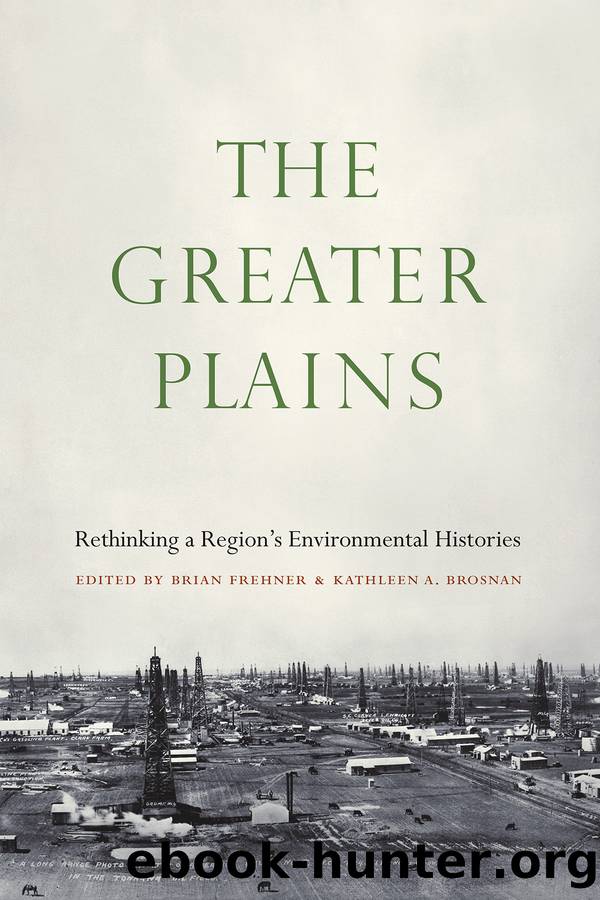The Greater Plains by Brian Frehner

Author:Brian Frehner
Language: eng
Format: epub
Tags: HIS036090 History / United States / State & Local / Midwest (ia, Il, In, Ks, Mi, Mn, Mo, Nd, Ne, Oh, Sd, Wi), HIS028000 History / Native American, NAT045020 Nature / Ecosystems & Habitats / Plains & Prairies
Publisher: University of Nebraska Press
Fig. 12. Ralph Parshall kneeling next to a Parshall Flume. It was common for Parshall to calibrate flumes for the specific needs of users. Irrigation Research Papers, CSU Morgan Library Archives and Special Collections. Used by permission.
Ralph Parshall possessed a faith in technocratic expertise that helps to explain his particularly instrumental view of rivers. As a water engineer, Parshallâs work drew fairly clean lines between conservation and preservation. When evaluating a river, he was concerned with its ability to supply water for people in perpetuity. Water unappropriated for human use was water wasted. It also explains his disdain for the management practices of mutual irrigation companies. By allowing so much water to be lost to seepage, poorly measured allocations, and ditch-side vegetation that gulped the passing flow, Parshall believed that these water managers were not just incompetent but also poor conservationists. Parshall did not value river water for its mere existence in the stream, for its support of flora and fauna, or for its ability to create esthetic beauty. Those were desirable only insofar as they supported a resource that could be renewed and reused in perpetuity.9 Moreover, as an engineer, his primary interaction with water occurred after it had been drawn from streams, when it flowed through engineered channels and into constructed lakes. The preeminent value of a watershed was in its ability to deliver water efficiently and in sufficient quantities. As an irrigation engineer, his primary purpose was to make a watershed yield the greatest quantity of usable water. And the highest praise Parshall could give to water managers was that they wasted not a single drop of the resource with which they were entrusted.
Ralph Parshallâs greatest contribution to efficient water management came from a device he invented in 1923. Eventually named after him in 1929, it was called the Parshall Flume, and it revolutionized the measuring of water in canals and ditches and, as a consequence, made water diversion more equitable. As Parshall saw it, the single greatest barrier to efficient water management was measurement. He argued that at least 25â30 percent of water was unavailable to junior appropriators due to measurement inaccuracies that enabled senior appropriators to take far more than their legally allotted share of water.10 The Parshall Flume capitalized on the previous work of hydrologists who had determined that there was a unique relationship between the depth of water and its flow. They identified what they called âcritical flow,â the point where water transitioned from slow and deep to fast and shallow, and a depth at which that flow could be measured. According to tests made by Parshall and his students, this new innovation had an error factor of less than 3 percent. If Parshallâs estimates were correct, this breakthrough could make 20 percent more water available to junior irrigators on the Piedmont by preventing senior appropriators from taking more than their allotted share. By 1927 the Parshall Flume was already being used in Hawaii, Canada, Central and South America, and Africa. Yet most irrigation companies on the Piedmont were not rushing to upgrade their aging systems.
Download
This site does not store any files on its server. We only index and link to content provided by other sites. Please contact the content providers to delete copyright contents if any and email us, we'll remove relevant links or contents immediately.
| Canada | Caribbean & West Indies |
| Central America | Greenland |
| Mexico | Native American |
| South America | United States |
Cat's cradle by Kurt Vonnegut(15265)
Pimp by Iceberg Slim(14441)
4 3 2 1: A Novel by Paul Auster(12334)
Underground: A Human History of the Worlds Beneath Our Feet by Will Hunt(12055)
The Radium Girls by Kate Moore(11978)
Wiseguy by Nicholas Pileggi(5716)
The Fire Next Time by James Baldwin(5390)
Perfect Rhythm by Jae(5361)
American History Stories, Volume III (Yesterday's Classics) by Pratt Mara L(5276)
Paper Towns by Green John(5142)
Pale Blue Dot by Carl Sagan(4961)
A Higher Loyalty: Truth, Lies, and Leadership by James Comey(4909)
The Mayflower and the Pilgrims' New World by Nathaniel Philbrick(4463)
The Doomsday Machine by Daniel Ellsberg(4453)
Killers of the Flower Moon: The Osage Murders and the Birth of the FBI by David Grann(4411)
The Sympathizer by Viet Thanh Nguyen(4346)
Too Much and Not the Mood by Durga Chew-Bose(4305)
The Borden Murders by Sarah Miller(4279)
Sticky Fingers by Joe Hagan(4148)
